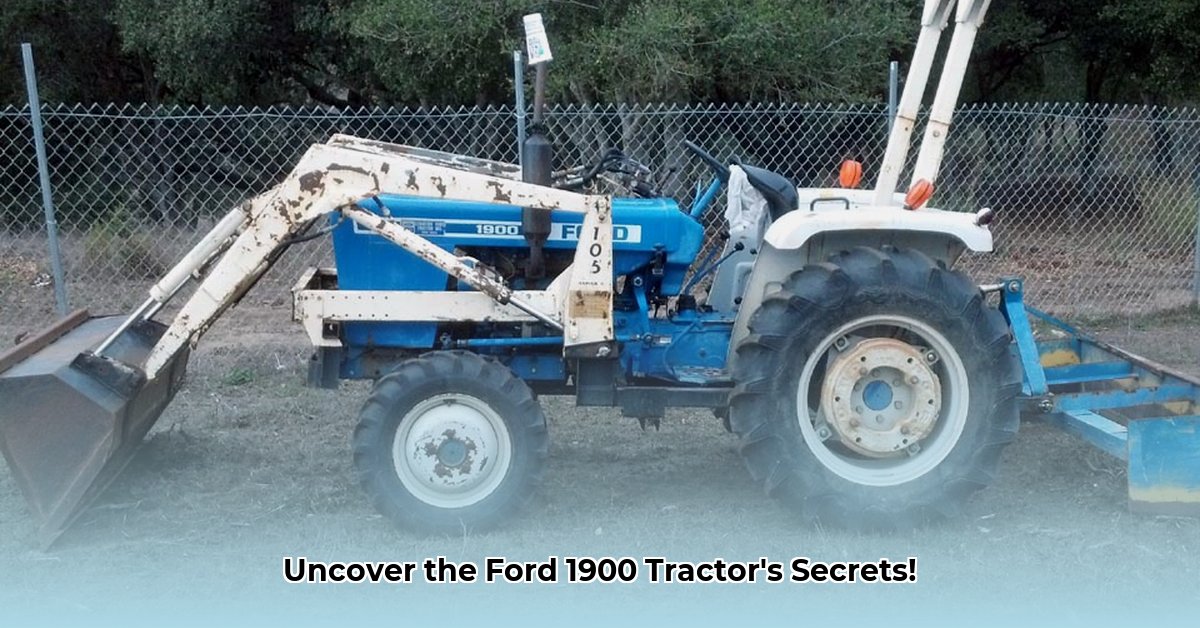
The Ford 1900 tractor, a compact yet capable machine produced from 1979 to 1983, holds a unique position in the world of vintage agricultural equipment. Built by Shibaura for Ford, this three-cylinder diesel tractor represents a bygone era of farming, offering a blend of robust construction and surprising versatility. This comprehensive guide delves into the Ford 1900's specifications, history, restoration, and continued relevance in a modern context. For more Ford tractor models, check out this useful resource.
Ford 1900 Tractor Specs: A Detailed Analysis
Pinpointing precise specifications for the Ford 1900 can be challenging due to variations in available documentation. However, we've compiled a summary of its key characteristics, acknowledging inconsistencies where they exist.
| Specification | Value(s) | Notes |
|---|---|---|
| Manufacturer | Ford (Engine manufactured by Shibaura) | A collaborative effort highlighting the industry dynamics of the era. |
| Production Years | 1979-1983 | Establishing its place within the agricultural technology timeline. |
| Engine | Shibaura LEM853, 3-cylinder diesel | A robust engine known for reliability in its time, though parts availability may now be a concern. |
| Engine Displacement | 1.4L | Relatively small displacement, contributing to its compact size and maneuverability. |
| Horsepower (estimated) | ~20-30 HP (PTO/Gross) | Variations likely stem from different testing methods and the evolution of the model. |
| Transmission | Manual, 12 forward/4 reverse gears | A simple transmission system, characteristic of the era. |
| PTO Power | Further research needed to establish accurate figures. | Original documentation is critical for confirming precise PTO horsepower. |
| Weight | Varies based on configuration and added attachments. | Specifications vary depending on the equipment attached. |
| Dimensions | Further research needed for complete dimensional data. | Precise dimensions would depend on specific configurations. |
Is the variation in reported horsepower simply a case of different testing standards, or does it indicate a shift in engine performance over the production run? Further research into original Ford documentation would help resolve these discrepancies.
Performance and Capabilities: A Compact Workhorse
The Ford 1900's compact size and maneuverability made it ideal for smaller farms and specialized tasks where larger tractors would be impractical. While not a powerhouse compared to modern equipment, its robust engine provided reliable power for tasks like tilling, mowing, and operating various implements. However, its capabilities are limited compared to its more modern counterparts. Did the Ford 1900's smaller size, perhaps a result of technology limitations, actually increase efficiency on smaller plots of land?
Attachments and Implements: Expanding its Versatility
The Ford 1900’s capabilities were significantly enhanced by its wide array of compatible implements. Common attachments included:
- Mowing decks: for maintaining pastureland and hayfields.
- Front-end loaders: for material handling.
- Snow blowers: for winter snow removal.
- Backhoes: used for trenching and utility work.
The availability of these implements further cemented the Ford 1900's reputation for versatility.
Restoring a Ford 1900: A Step-by-Step Guide
Restoring a Ford 1900 is a labor of love, but a rewarding one for those with mechanical aptitude and patience. The process involves several key steps:
- Assessment: Thoroughly inspect the tractor to identify parts needing repair or replacement.
- Disassembly: Carefully dismantle the tractor, thoroughly documenting the process for reassembly.
- Cleaning and Repair: Clean and repair or replace individual components, a task requiring patience and specialized tools.
- Reassembly: Follow your documentation to accurately reassemble the tractor.
- Testing: Conduct rigorous testing to ensure all systems function correctly.
It’s important to note that sourcing parts can be challenging, requiring persistence and research through online forums and vintage tractor parts suppliers.
A Piece of Farming History: The Ford 1900 in Context
The Ford 1900 offers a glimpse into a past era of agricultural technology. Compared to modern tractors, its technology is simpler, but its reliability and easy-to-understand design made it a valuable asset for many farmers in the late 70s and early 80s. The Ford 1900 represents practicality over high-tech features. How did this focus on simpler engineering impact the Ford 1900’s long-term durability and sustainability compared to its more complex modern counterparts?
The Ford 1900 Today: Continued Relevance
Despite its age, the Ford 1900 still holds value. Its compact size and maneuverability are well-suited to small-scale farming operations, hobby farms, and specific tasks where larger tractors would be unwieldy. Its lower operating costs and simpler maintenance compared to contemporary models also make it attractive for those on a budget. However, potential buyers should weigh the benefits against the limitations presented by its age and the relative lack of modern technological advancements.
Safety First: Responsible Operation of Vintage Machinery
Always prioritize safety when operating vintage equipment. Regular maintenance, careful pre-operation checks, and the use of safety features like ROPS (Roll Over Protective Structure), if available, are critical for safe operation.
In conclusion, the Ford 1900 tractor embodies a fascinating combination of historical significance and enduring practicality. Its specifications, while not always definitively stated, reveal a sturdy, versatile machine that continues to resonate with enthusiasts and practical farmers alike.